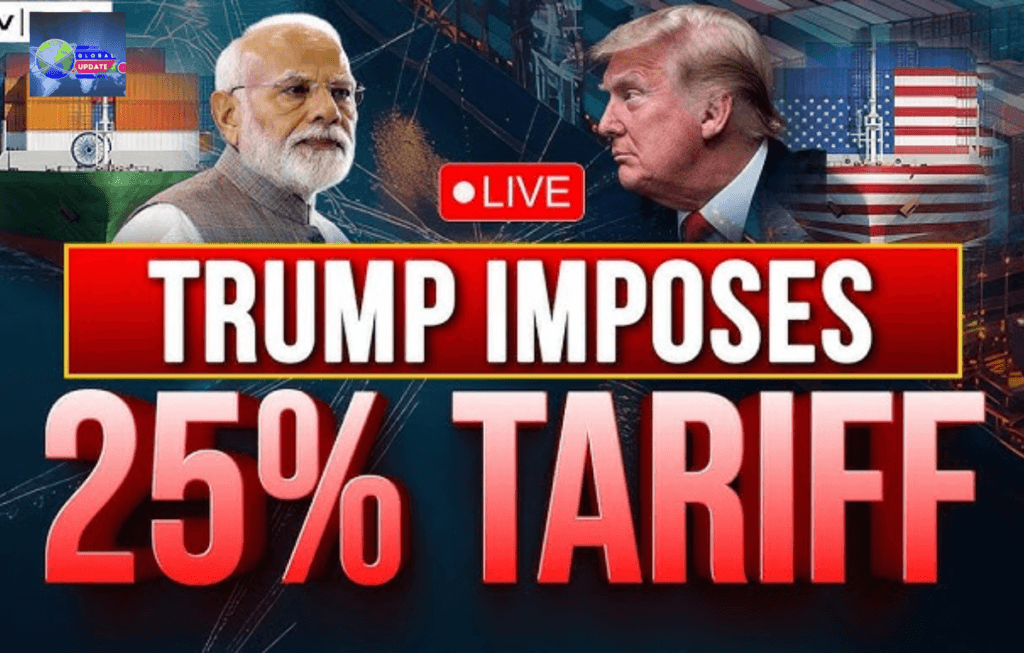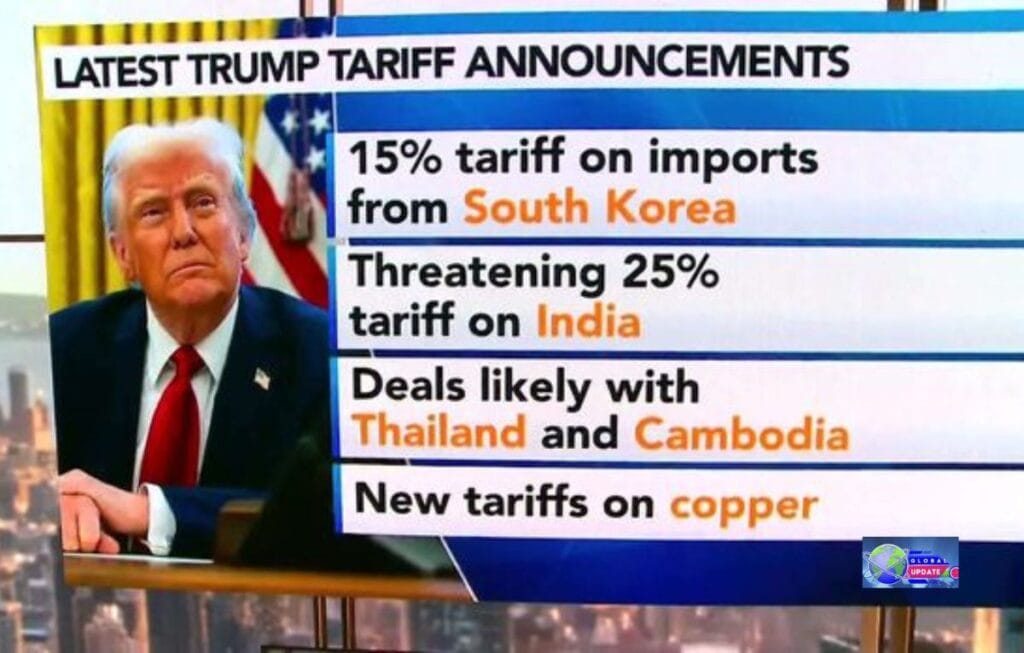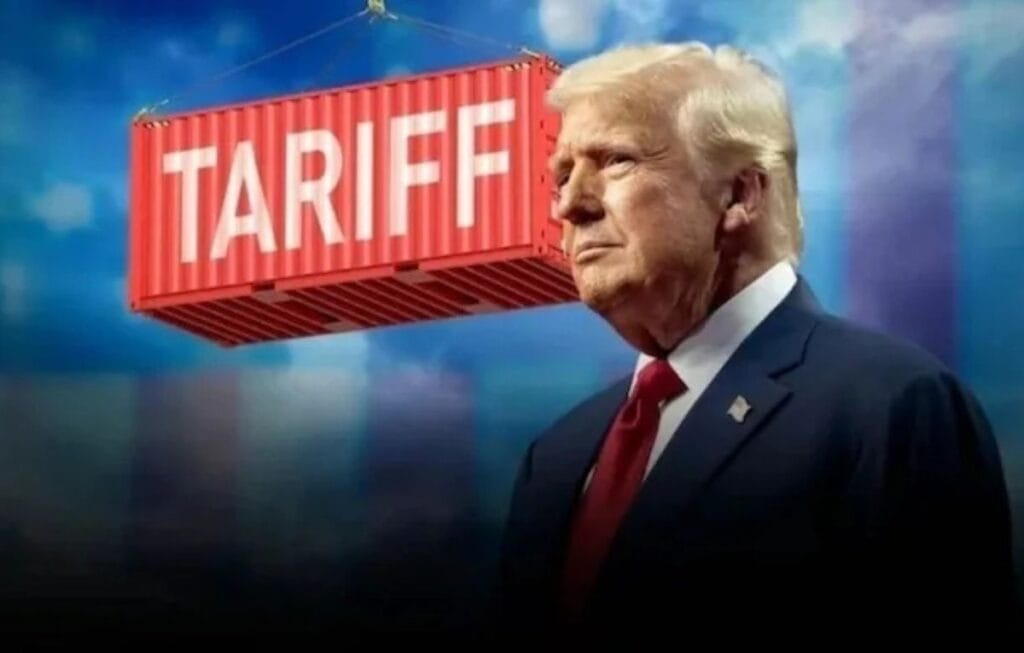Experts warned that President Donald Trump’s 25% tariffs on items imported from India may harm the country’s growth prospects.
Understanding the Impact of Trump’s 25% Tariff Proposal
It is uncertain how significant the blow will be, considering that Trump has proposed an undetermined penalty in addition to Trump’s 25% tariffs rate.
In a tweet on his Truth Social platform on Wednesday, Trump stated that India would face a penalty beginning August 1 for purchasing Russian oil and weapons “at a time when everyone wants Russia to STOP.”
Experts think further information on the small print of the penalty would be critical in determining the decision’s actual economic impact.

“The tariff (and penalty) imposed by the US is larger than expected and is hence likely to impede India’s GDP development. Aditi Nayar, chief economist at ratings agency Icra, said in a statement that the level of the penalties imposed will determine the degree of the negative impact.
ICRA recently cut its GDP prediction for India for this fiscal year from 6.5% to 6.2% due to the negative impact of tariff increases.
Another brokerage, Nomura, stated that the tariffs were “growth negative” and that the announcements might reduce India’s GDP by 0.2%.
Markets responded unfavorably to the news, opening in the red as the day’s trading began.
“The market expecting a tariff deal to work out, as longer-term US-India strategic interests are aligned,” said Nilesh Shah, a fund manager.
The United States has undertaken many rounds of trade talks in recent months, with Delhi even lowering tariffs on commodities such as bourbon whiskey and motorcycles to appease the US.
However, the US has a $45 billion (£33 billion) trade gap with India, which Trump wants to minimize.
A 25% tax plus additional fines will put India at a disadvantage in comparison to other Asian nations such as Vietnam and China, “the main countries we are competing against for investment and industrialization,” according to Rahul Ahluwalia of the Foundation for Economic Development think tank.
US tariffs on Chinese goods reduced from 145% to 30% following agreements in Geneva and London.
The two parties now have until August 12 to finalize a long-term trade agreement. Trump also signed a deal with Vietnam in early July, agreeing to levy 20% tariffs instead of the 46% announced in April.
India’s tariffs have now surpassed those of other countries. It unlikely that export supply chains in sectors such as textiles will diverted to India.
“If the tariff is maintained, this move may have a direct impact on key sectors such as marine products, pharmaceuticals, textiles, leather, and automobiles, where bilateral trade has robust,” said Agneshwar Sen, trade policy expert at EY India.
Trump would impose 25% tariffs on India, plus a ‘penalty’ for trade with Russia.
What tariffs has Trump imposed, and why? Is the ‘great, beautiful’ India-US trade agreement in trouble?
India’s economists, exporters, and industry executives all expressed regret and anxiety in response to Trump’s announcement.
“While this move is unfortunate and will have a direct impact on our exports, we hope that the imposition of higher tariffs will be a temporary phenomenon and that a permanent trade agreement between the two sides will be finalized soon,” Mr. Harsha Vardhan Agarwal, president of industry body FICCI, said.
A federation of Indian exporting organizations said the duties will prompt new pricing negotiations between US purchasers and Indian sellers to determine how much of the 25% increase exporters can bear.

Tariffs are typically charges levied against commodities imported from other countries.
Higher tariffs have an indirect impact on exporters since they increase the cost of goods for end consumers, resulting in lower demand.
Encourage exporters to lower their pricing to remain competitive, which in turn reduces their profit margins.
In a press release, India’s trade ministry stated that it is investigating the “implications” of Trump’s proposal.
Stated that the government is still committed to a mutually beneficial bilateral trade pact.
“importance on protecting and promoting the welfare of our farmers, entrepreneurs, and MSMEs [micro, small, and medium enterprises]”—an “indication that areas such as agriculture, dairy, and other politically sensitive sectors have become key sticking points that derailed the negotiations.”
After the statement, India’s opposition Congress party launched a scathing attack on the government.
In a post on “It is a catastrophic failure in foreign policy.”
How Does Trump’s Trade Deal Complicate India-Russia Ties?
Trump’s hype of the trade deal with India’s economic ties with Russia “complicates the situation,” according to Mark Linscott.
Mark Linscott is a former US government trade representative and a member of the US-India Strategic Partnership Forum.
“They add a “whole new dimension to the negotiations, and it’s not clear how this set of issues can be added to a trade package.”
Since the start of the war in Ukraine, India has steadfastly defended its historic relations with Russia, as well as its oil purchases. India asserts that, as a nation dependent on energy imports, it will bear the utmost cost to ensure the welfare of millions of impoverished Indians.
Mr. Linscott stated that, notwithstanding the obstacles, both India and the US have significant shared interests in reopening negotiations and reaching an interim agreement.
The United States is India’s most crucial foreign export market, with bilateral trade of $190 billion and a declared objective of reaching $500 billion in the coming years.
The president is adamant about personally approving all deals. For that to happen in India, I believe Prime Minister Modi must reach out to the president directly to negotiate the final elements.
This includes any headline promises regarding energy and military equipment purchases, as well as investments in the United States.
For whatever reason, that didn’t happen. India’s reliance on Russian armaments has also been gradually decreasing.
India and the US face significant obstacles; however, they share interests in reopening negotiations and reaching an interim agreement.
The United States is India’s most crucial foreign export market, with bilateral trade of $190 billion and a declared objective of reaching $500 billion in the coming years.
The president is adamant about personally approving all deals.
To make progress in India, I believe Prime Minister Modi must reach out to the president directly to negotiate the final elements. This encompasses any significant commitments on energy and military equipment acquisitions, along with investments in the US.
He went on to explain why that didn’t happen.
Although Trump has described India as a “good friend,” he has regularly criticized the country’s high tariffs.

On Thursday morning, he sent an especially scathing comment on his Truth Social platform, saying, “I don’t care what India does with Russia.”
For all I care, they can bring down their dead economies together.
I have done very little business with India, and their tariffs are among the highest in the world.
Despite the rising tensions, negotiations between India and the US set to continue through August, with a US team visiting India later next month to finalize a complete trade agreement.
Many people hope that tariffs will bargained lower and that the higher reciprocal tariff rate of 25% will only temporary until a thorough trade agreement with the United States reached. The two sides have set a final deadline to reach an agreement.
However, the best-case scenario would still involve tariffs in the 15-20% range, which is disappointing given India’s more advanced stage of negotiations, according to Nomura.
While the impact could mitigated, given that the Indian economy more domestically oriented and less reliant on goods trade than other Asian peers, Nomura believes Trump’s decision will “increase the likelihood of monetary policy easing” and prompt India’s central bank to cut interest rates further to protect growth.



